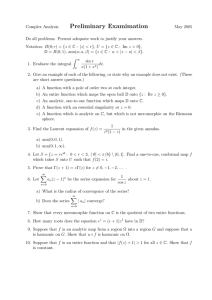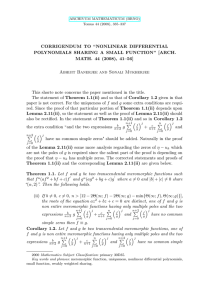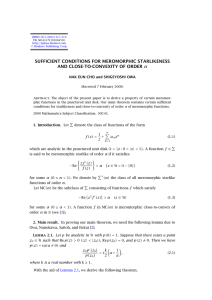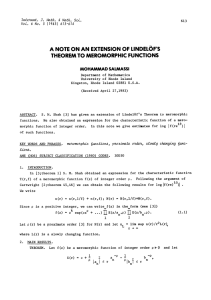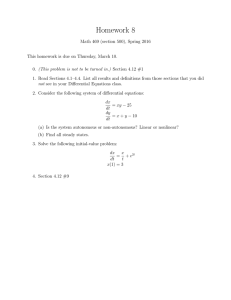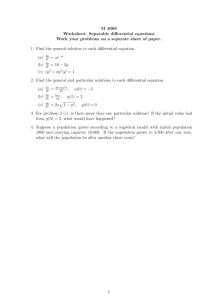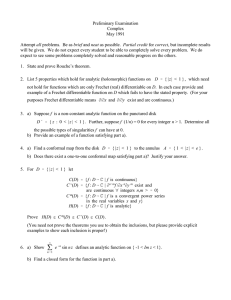60 (2008), 233–246 GROWTH AND OSCILLATION THEORY OF SOLUTIONS Benharrat Bela¨ıdi
advertisement
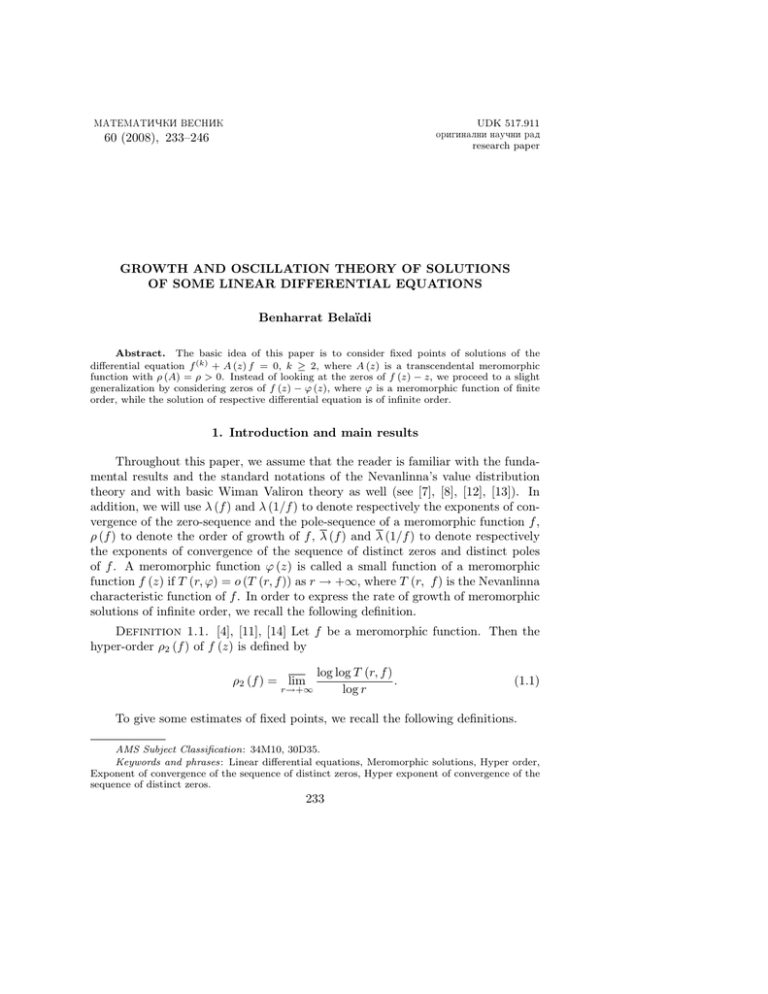
MATEMATIQKI VESNIK
UDK 517.911
originalni nauqni rad
research paper
60 (2008), 233–246
GROWTH AND OSCILLATION THEORY OF SOLUTIONS
OF SOME LINEAR DIFFERENTIAL EQUATIONS
Benharrat Belaı̈di
Abstract. The basic idea of this paper is to consider fixed points of solutions of the
differential equation f (k) + A (z) f = 0, k ≥ 2, where A (z) is a transcendental meromorphic
function with ρ (A) = ρ > 0. Instead of looking at the zeros of f (z) − z, we proceed to a slight
generalization by considering zeros of f (z) − ϕ (z), where ϕ is a meromorphic function of finite
order, while the solution of respective differential equation is of infinite order.
1. Introduction and main results
Throughout this paper, we assume that the reader is familiar with the fundamental results and the standard notations of the Nevanlinna’s value distribution
theory and with basic Wiman Valiron theory as well (see [7], [8], [12], [13]). In
addition, we will use λ (f ) and λ (1/f ) to denote respectively the exponents of convergence of the zero-sequence and the pole-sequence of a meromorphic function f ,
ρ (f ) to denote the order of growth of f , λ (f ) and λ (1/f ) to denote respectively
the exponents of convergence of the sequence of distinct zeros and distinct poles
of f . A meromorphic function ϕ (z) is called a small function of a meromorphic
function f (z) if T (r, ϕ) = o (T (r, f )) as r → +∞, where T (r, f ) is the Nevanlinna
characteristic function of f . In order to express the rate of growth of meromorphic
solutions of infinite order, we recall the following definition.
Definition 1.1. [4], [11], [14] Let f be a meromorphic function. Then the
hyper-order ρ2 (f ) of f (z) is defined by
log log T (r, f )
.
r→+∞
log r
ρ2 (f ) = lim
(1.1)
To give some estimates of fixed points, we recall the following definitions.
AMS Subject Classification: 34M10, 30D35.
Keywords and phrases: Linear differential equations, Meromorphic solutions, Hyper order,
Exponent of convergence of the sequence of distinct zeros, Hyper exponent of convergence of the
sequence of distinct zeros.
233
234
B. Belaı̈di
Definition 1.2. [4], [10], [11] Let f be a meromorphic function. Then the
exponent of convergence of the sequence of distinct fixed points of f (z) is defined
by
³
´
1
log N r, f −z
τ (f ) = λ (f − z) = lim
,
(1.2)
r→+∞
log r
³
´
where N r, f1 is the counting function of distinct zeros of f (z) in {|z| < r}.
Definition 1.3. [9], [10], [11] Let f be a meromorphic function. Then the
hyper exponent of convergence of the sequence of distinct zeros of f (z) is defined
by
³
´
log log N r, f1
.
(1.3)
λ2 (f ) = lim
r→+∞
log r
Definition 1.4. [10], [11], [14] Let f be a meromorphic function. Then the
hyper exponent of convergence of the sequence of distinct fixed points of f (z) is
defined by
³
´
1
log log N r, f −z
τ 2 (f ) = λ2 (f − z) = lim
.
(1.4)
r→+∞
log r
Thus τ 2 (f ) = λ2 (f − z) is an indication of oscillation of distinct fixed points of
f (z).
For k ≥ 2, we consider the linear differential equation
f (k) + A (z) f = 0,
(1.5)
where A (z) is a transcendental meromorphic function with finite order ρ (A) =
ρ > 0. Many important results have been obtained on the fixed points of general
transcendental meromorphic functions for almost four decades (see [16]). However,
there are a few studies on the fixed points of solutions of differential equations. It
was in year 2000 that Z. X. Chen first pointed out the relation between the exponent
of convergence of distinct fixed points and the rate of growth of solutions of second
order linear differential equations with entire coefficients (see [4]). In [14], Wang and
Yi investigated fixed points and hyper order of differential polynomials generated by
solutions of second order linear differential equations with meromorphic coefficients.
In [10], Laine and Rieppo gave improvement of the results of [14] by considering
fixed points and iterated order. In [15], Wang and Lü have investigated the fixed
points and hyper order of solutions of second order linear differential equations
with meromorphic coefficients and their derivatives and have obtained the following
result:
Theorem A. [15] Suppose that A (z) is a transcendental meromorphic function
satisfying δ (∞, A) = limr→+∞ m(r,A)
T (r,A) = δ > 0, ρ (A) = ρ < +∞. Then every
meromorphic solution f (z) 6≡ 0 of the equation
f 00 + A (z) f = 0,
(1.6)
Growth and oscillation of solutions of linear differential equations
235
satisfies that f and f 0 , f 00 all have infinitely many fixed points and
0
00
τ (f ) = τ (f ) = τ (f ) = ρ (f ) = +∞,
0
00
τ 2 (f ) = τ 2 (f ) = τ 2 (f ) = ρ2 (f ) = ρ.
(1.7)
(1.8)
Recently, Theorem A has been generalized to higher order differential equations
by Liu Ming-Sheng and Zhang Xiao-Mei as follows [11]:
Theorem B. [11] Suppose that k ≥ 2 and A (z) is a transcendental meromorphic function satisfying δ (∞, A) = limr→+∞ m(r,A)
T (r,A) = δ > 0, ρ (A) = ρ < +∞.
Then every meromorphic solution f (z) 6≡ 0 of (1.5), satisfies that f and f 0 , f 00 ,
. . . , f (k) all have infinitely many fixed points and
τ (f ) = τ (f 0 ) = · · · = τ (f (k) ) = ρ (f ) = +∞,
0
τ 2 (f ) = τ 2 (f ) = · · · = τ 2 (f
(k)
) = ρ2 (f ) = ρ.
(1.9)
(1.10)
The main purpose of this paper is to study the relation between solutions and
their derivatives of the differential equation (1.5) and small meromorphic functions.
We obtain an extension of Theorems A–B. In fact, we prove the following results:
Theorem 1.1. Let A (z) be a transcendental meromorphic function of finite
order ρ (A) = ρ > 0 such that δ (∞, A) = δ > 0. Suppose, moreover, that either:
(i) all poles of f are of uniformly bounded multiplicity or that
(ii) δ (∞, f ) > 0.
Let dj (j = 0, 1, 2) be polynomials that are not all equal to zero, ϕ (z) (6≡ 0) be a
meromorphic function of finite order. If f (z) 6≡ 0 is a meromorphic solution of
(1.6) with λ(1/f ) < +∞, then the differential polynomial g (z) = d2 f 00 + d1 f 0 + d0 f
satisfies λ (g − ϕ) = +∞.
Theorem 1.2. Let k ≥ 2 and A (z) be a transcendental meromorphic function
of finite order ρ (A) = ρ > 0 such that δ (∞, A) = δ > 0. Suppose, moreover, that
either:
(i) all poles of f are of uniformly bounded multiplicity or that
(ii) δ (∞, f ) > 0.
If ϕ (z) 6≡ 0 is a meromorphic function with finite order ρ (ϕ) < +∞, then every
meromorphic solution f (z) 6≡ 0 of (1.5), satisfies
λ (f − ϕ) = λ(f 0 − ϕ) = · · · = λ(f (k) − ϕ) = ρ (f ) = +∞,
0
λ2 (f − ϕ) = λ2 (f − ϕ) = · · · = λ2 (f
(k)
− ϕ) = ρ2 (f ) = ρ.
(1.11)
(1.12)
Setting ϕ (z) = z in Theorem 1.1 and Theorem 1.2, we obtain the following
corollaries:
236
B. Belaı̈di
Corollary 1.1. Let A (z) be a transcendental meromorphic function of finite
order ρ (A) = ρ > 0 such that δ (∞, A) = δ > 0. Suppose, moreover, that either:
(i) all poles of f are of uniformly bounded multiplicity or that
(ii) δ (∞, f ) > 0.
Let dj (j = 0, 1, 2) be polynomials that³ are
´ not all equal to zero. If f (z) 6≡ 0 is a
meromorphic solution of (1.6) with λ
00
1
f
< +∞, then the differential polynomial
0
g (z) = d2 f + d1 f + d0 f has infinitely many fixed points and satisfies λ (g − z) =
+∞.
Corollary 1.2. Let k ≥ 2 and A (z) be a transcendental meromorphic function of finite order ρ (A) = ρ > 0 such that δ (∞, A) = δ > 0. Suppose, moreover,
that either:
(i) all poles of f are of uniformly bounded multiplicity or that
(ii) δ (∞, f ) > 0.
Then every meromorphic solution f (z) 6≡ 0 of (1.5), satisfies that f and f 0 , f 00 ,
. . . , f (k) all have infinitely many fixed points and
τ (f ) = τ (f 0 ) = τ (f 00 ) = · · · = τ (f (k) ) = ρ (f ) = +∞,
(1.13)
τ 2 (f ) = τ 2 (f 0 ) = τ 2 (f 00 ) = · · · = τ 2 (f (k) ) = ρ2 (f ) = ρ.
(1.14)
2. Some Lemmas
We need the following lemmas in the proofs of our theorems.
Lemma 2.1. [6] Let f be a transcendental meromorphic function of finite order
ρ, let Γ = {(k1 , j1 ) , (k2 , j2 ) , . . . , (km , jm )} denote a finite set of distinct pairs of
integers that satisfy ki > ji ≥ 0 for i = 1, . . . , m and let ε > 0 be a given constant.
Then the following estimations hold:
(i) There exists a set E1 ⊂ [0, 2π) that has linear measure zero, such that if ψ ∈
[0, 2π) − E1 , then there is a constant R1 = R1 (ψ) > 1 such that for all z satisfying
arg z = ψ and |z| ≥ R1 and for all (k, j) ∈ Γ, we have
¯ (k)
¯
¯ f (z) ¯
(k−j)(ρ−1+ε)
¯
¯
.
(2.1)
¯ f (j) (z) ¯ ≤ |z|
(ii) There exists a set E2 ⊂ (1, ∞) that has finite logarithmic measure lm (E2 ) =
R +∞ χE2 (t)
dt < +∞, where χE2 is the characteristic function of E2 , such that for
t
1
all z satisfying |z| ∈
/ E2 ∪ [0, 1] and for all (k, j) ∈ Γ, we have
¯
¯ (k)
¯ f (z) ¯
(k−j)(ρ−1+ε)
¯
¯
.
(2.2)
¯ f (j) (z) ¯ ≤ |z|
Growth and oscillation of solutions of linear differential equations
237
We recall a special case of an important result due to Chiang and Hayman
in [5]:
Lemma 2.2. [5] Let f be a meromorphic solution of the differential equation
f (n) + An−1 (z) f (n−1) + · · · + A1 (z) f 0 + A0 (z) f = 0
(2.3)
in the complex plane, assuming that not all coefficients Aj (z) are constants. Given
Pn−1
a real constant σ > 1, and denoting T (r) := j=0 T (r, Aj ), we have
σ
log m (r, f ) < r1+σ T (r) {log T (r)}
(2.4)
outside of an exceptional set E3 of finite linear measure.
To avoid some problems caused by the exceptional set we recall the following
Lemma.
Lemma 2.3. ([1, p. 68]). Let g : [0, +∞) → R and h : [0, +∞) → R be monotone non-decreasing functions such that g (r) ≤ h (r) outside of an exceptional set
E4 of finite linear measure. Then for any α > 1, there exists r0 > 0 such that
g (r) ≤ h (αr) for all r > r0 .
Lemma 2.4. Let k ≥ 2 and A (z) be a transcendental meromorphic function
of finite order ρ (A) = ρ > 0 such that δ (∞, A) = δ > 0. Suppose, moreover, that
either:
(i) all poles of f are of uniformly bounded multiplicity or that
(ii) δ (∞, f ) > 0.
Then every meromorphic solution f (z) 6≡ 0 of (1.5) satisfies ρ (f ) = +∞ and
ρ2 (f ) = ρ (A) = ρ.
Proof. First, we prove that ρ (f ) = +∞. We suppose that ρ (f ) = β < +∞
and then we obtain a contradiction. Rewrite (1.5) as
A=−
f (k)
.
f
(2.5)
By ρ (f ) = β < +∞, we have
µ
¶
f (k)
m r,
= O (log r) .
f
(2.6)
It follows from the definition of deficiency δ (∞, A) that for sufficiently large r, we
have
δ
m (r, A) ≥ T (r, A) .
(2.7)
2
So when r sufficiently large, we have by (2.5)–(2.7)
µ
¶
2
2
f (k)
T (r, A) ≤ m (r, A) = m r,
= O (log r) .
(2.8)
δ
δ
f
238
B. Belaı̈di
Therefore, by (2.8), we obtain a contradiction since A is a transcendental meromorphic function with ρ (A) = ρ > 0. Hence ρ (f ) = +∞.
Now, we prove that γ = ρ2 (f ) = ρ (A) = ρ. By ρ (f ) = +∞, there exists a set
E with finite linear measure such that
µ
¶
f (k)
= O (log (rT (r, f )))
(2.9)
m r,
f
for r ∈
/ E. It follows from the definition of deficiency δ(∞, A) and (2.9) that for
sufficiently large r ∈
/ E, we have
µ
¶
2
2
f (k)
T (r, A) ≤ m (r, A) = m r,
= O (log (rT (r, f ))) .
(2.10)
δ
δ
f
By Lemma 2.3, we have for any α > 1
T (r, A) ≤ O (log (αrT (αr, f ))) .
(2.11)
for sufficiently large r. Hence by the definition of hyper-order, we obtain that
γ = ρ2 (f ) = lim
r→+∞
log log T (r, f )
≥ ρ (A) = ρ.
log r
(2.12)
To prove the converse inequality, we observe that all poles of f occur at the poles
of A only. If the multiplicity of the poles of f is uniformly bounded, we have
¡
¢
T (r, f ) = m (r, f ) + O N (r, A) = m (r, f ) + O (T (r, A)) ,
(2.13)
while if δ (∞, f ) > 0, then
T (r, f ) = O (m (r, f )) .
(2.14)
Applying now either (2.13) or (2.14) with Lemma 2.2 and Lemma 2.3, we immediately get the required reversed inequality.
Lemma 2.5. [3] Let A0 , A1 , . . . , Ak−1 , F 6≡ 0 be finite order meromorphic
functions. If f is a meromorphic solution with ρ (f ) = +∞ of the equation
f (k) + Ak−1 f (k−1) + · · · + A1 f 0 + A0 f = F,
(2.15)
then λ (f ) = λ (f ) = ρ (f ) = +∞.
Lemma 2.6 Let A0 , A1 , . . . , Ak−1 , F 6≡ 0 be finite order meromorphic functions. If f is a meromorphic solution of the equation (2.15) with ρ (f ) = +∞ and
ρ2 (f ) = ρ, then f satisfies λ2 (f ) = λ2 (f ) = ρ2 (f ) = ρ.
Proof. By equation (2.15), we can write
Ã
!
0
1 f (k)
f (k−1)
f
1
=
+ Ak−1
+ · · · + A1 + A0 .
f
F
f
f
f
(2.16)
Growth and oscillation of solutions of linear differential equations
239
If f has a zero at z0 of order α (> k) and if A0 , A1 , . . . , Ak−1 are all analytic at
z0 , then F has a zero at z0 of order at least α − k. Hence,
µ
¶
µ
¶
µ
¶ k−1
P
1
1
1
n r,
≤ k n r,
+ n r,
+
n (r, Aj )
(2.17)
f
f
F
j=0
and
µ
¶
µ
¶
µ
¶ k−1
P
1
1
1
N r,
≤ k N r,
+ N r,
+
N (r, Aj ) .
f
f
F
j=0
By (2.16), we have
µ
¶
µ
¶ k−1
µ
¶
k
P
P
1
f (j)
1
m r,
≤
m r,
+
m (r, Aj ) + m r,
+ O (1) .
f
f
F
j=1
j=0
Applying the Lemma of the logarithmic derivative (see [8]), we have
µ
¶
f (j)
m r,
= O (log T (r, f ) + log r) (j = 1, . . . , k) ,
f
(2.18)
(2.19)
(2.20)
holds for all r outside a set E ⊂ (0, +∞) with a finite linear measure m (E) < +∞.
By (2.18), (2.19) and (2.20), we get
µ
¶
1
T (r, f ) = T r,
+ O (1)
f
³ 1 ´ k−1
P
≤ kN r,
+
T (r, Aj ) + T (r, F ) + O (log (rT (r, f ))) (|z| = r ∈
/ E) .
f
j=0
(2.21)
Since ρ (f ) = +∞, then there exists {rn0 } (rn0 → +∞) such that
log T (rn0 , f )
= +∞.
rn →+∞
log rn0
lim
0
(2.22)
Set the linear measure of E, m (E) = γ < +∞, then there exists a point rn ∈
[rn0 , rn0 + γ + 1] − E. From
³ 0 ´
log
T
rn , f
log T (rn , f )
log T (rn0 , f )
,
(2.23)
=
≥
0
log rn
log (rn + γ + 1)
log rn0 + log (1 + (γ + 1) /rn0 )
it follows that
log T (rn , f )
= +∞.
(2.24)
log rn
Set σ = max{ ρ(Aj ) | j = 0, . . . , k − 1, ρ(F ) }. Then for a given arbitrary large
β > σ,
T (rn , f ) ≥ rnβ
(2.25)
lim
rn →+∞
holds for sufficiently large rn . On the other hand, for any given ε with 0 < 2ε <
β − σ, we have
T (rn , Aj ) ≤ rnσ+ε (j = 0, . . . , k − 1) , T (rn , F ) ≤ rnσ+ε
(2.26)
240
B. Belaı̈di
for sufficiently large rn . Hence, we have
½
¾
T (rn , F ) T (rn , Aj )
rσ+ε
max
,
(j = 0, . . . , k − 1) ≤ nβ → 0, rn → +∞. (2.27)
T (rn , f ) T (rn , f )
rn
Therefore,
1
1
T (rn , F ) ≤
T (rn , f ) , T (rn , Aj ) ≤
T (rn , f ) (j = 0, . . . , k − 1)
k+3
k+3
(2.28)
holds for sufficiently large rn . From
O (log rn + log T (rn , f )) = o (T (rn , f )) ,
(2.29)
we obtain that
1
T (rn , f )
(2.30)
k+3
also holds for sufficiently large rn . Thus, by (2.21), (2.28), (2.30), we have
µ
¶
1
T (rn , f ) ≤ k (k + 3) N rn ,
.
(2.31)
f
O (log rn + log T (rn , f )) ≤
It yields λ2 (f ) = λ2 (f ) = ρ2 (f ) = ρ.
P∞
Lemma 2.7. [7,p. 344] Let f (z) = n=0 an z n be an entire function, µ (r) be
the maximum term, i.e., µ (r) = max{|an | rn | n = 0, 1, . . . } and let νf (r) be the
central index of f , i.e., νf (r) = max{m, µ (r) = |am | rm }. Then
d
2
2
log µ (r) < [log µ (r)] ≤ [log M (r, f )]
dr
holds outside a set E5 ⊂ (1, +∞) of r of finite logarithmic measure.
νf (r) = r
(2.32)
Lemma 2.8. (Wiman-Valiron, [7], [13]) Let f (z) be a transcendental entire
function, and let z be a point with |z| = r at which |f (z)| = M (r, f ). Then the
estimation
µ
¶k
f (k) (z)
νf (r)
=
(1 + o (1)) (k > 1 is an integer),
(2.33)
f (z)
z
holds for all |z| outside a set E6 of r of finite logarithmic measure.
Lemma 2.9. [2] Suppose that f (z) is a meromorphic function with ρ (f ) = β <
+∞. Then for any given ε > 0, there is a set E7 ⊂ (1, +∞) of finite logarithmic
measure, such that
©
ª
|f (z)| ≤ exp rβ+ε
(2.34)
holds for |z| = r ∈
/ [0, 1] ∪ E7 , r → +∞.
Lemma 2.10. Let f (z) be a meromorphic function with ρ (f ) = +∞ and the
exponent of convergence of the poles of f (z), λ (1/f ) < +∞. Let dj (z) (j = 0, 1, 2)
be polynomials that are not all equal to zero. Then
00
0
g (z) = d2 (z) f + d1 (z) f + d0 (z) f
satisfies ρ (g) = +∞.
(2.35)
Growth and oscillation of solutions of linear differential equations
241
Proof. We suppose that ρ (g) = ρ < +∞ and then we obtain a contradiction.
First, we suppose that d2 (z) 6≡ 0. Set f (z) = w (z) /h (z), where h (z) is canonical
product (or polynomial) formed with the non-zero poles of f (z), λ (h) = ρ (h) =
λ (1/f ) = ρ1 < +∞, w (z) is an entire function with ρ (w) = ρ (f ) = +∞. We have
2
f 0 (z) =
w 0 h − h0 w
w00
wh00
w 0 h0
(h0 ) w
00
and
f
(z)
=
−
−
2
+
2
.
h2
h
h2
h2
h3
(2.36)
Hence
2
f 00 (z)
w00
h00
w 0 h0
(h0 )
=
−
−2
+2 2 ,
f (z)
w
h
wh
h
0
0
0
w
h
f (z)
=
− .
f (z)
w
h
(2.37)
(2.38)
By Lemma 2.1 (ii), there exists a set E1 ⊂ (1, +∞) that has finite logarithmic
measure, such that for all z satisfying |z| ∈
/ E1 ∪ [0, 1], we have
¯ (j) ¯
¯ h (z) ¯
j (ρ1 −1+ε)
¯
¯
(j = 1, 2) .
(2.39)
¯ h(z) ¯ ≤ |z|
Substituting (2.39) into (2.37) and (2.38), we obtain for all z satisfying |z| ∈
/ E1 ∪
[0, 1]
f 00 (z)
w00
w0
=
+ O (z α )
+ O (z α ) ,
f (z)
w
w
f 0 (z)
w0
=
+ O (z α ) ,
f (z)
w
(2.40)
(2.41)
where α (0 < α < +∞) is a constant and may be different at different places. Substituting (2.40) and (2.41) into (2.35), we obtain
¶
µ 0
¶
µ 00
w0
w
g (z) h (z)
w
+ O (z α )
+ O (z α ) + d1 (z)
+ O (z α ) + d0 (z) =
.
d2 (z)
w
w
w
w (z)
(2.42)
It follows that
w00
w0
d2 (z)
+ (O (z α ) d2 (z) + d1 (z))
+ O (z α ) d2 (z) + O (z α ) d1 (z) + d0 (z)
w
w
g (z) h (z)
. (2.43)
=
w (z)
Hence,
w0
g (z) h (z)
w00
+ O (z m )
+ O (z m ) =
,
(2.44)
w
w
w (z)
where m (0 < m < +∞) is some constant. By Lemma 2.8, there exists a set E2 ⊂
(1, +∞) with logarithmic measure lm (E2 ) < +∞ and we can choose z satisfying
|z| = r ∈
/ [0, 1] ∪ E2 , and |w (z)| = M (r, w), such that
µ
¶j
νw (r)
w(j) (z)
=
(1 + o (1)) (j = 1, 2).
(2.45)
w (z)
z
d2 (z)
242
B. Belaı̈di
Since ρ (g) = ρ < +∞ and ρ (h) = λ (1/f ) = ρ1 < +∞ by Lemma 2.9, there
exists a set E3 that has finite logarithmic measure, such that for all z satisfying
|z| = r ∈
/ [0, 1] ∪ E3 , r → +∞ we have
©
ª
©
ª
|g (z)| ≤ exp rρ+1 , |h (z)| ≤ exp rρ1 +1 .
(2.46)
By Lemma 2.7, there is a set E4 ⊂ (1, +∞) that has finite logarithmic measure,
such that for all z satisfying |z| = r ∈
/ [0, 1] ∪ E4 , we have
2
|νw (r)| < (log M (r, w)) .
(2.47)
Since ρ (w) = +∞, there exists {rn0 } (rn0 → +∞) such that
log νw (rn0 )
= +∞.
rn →+∞
log rn0
(2.48)
lim
0
Set the logarithmic measure of E1 ∪ E2 ∪ E3 ∪ E4 ,
lm (E1 ∪ E2 ∪ E3 ∪ E4 ) = γ < +∞,
then there exists a point rn ∈ [rn0 , (γ + 1) rn0 ] − E1 ∪ E2 ∪ E3 ∪ E4 . From
log νw (rn0 )
log νw (rn )
log νw (rn0 )
´
³
=
,
≥
log rn
log ((γ + 1) rn0 )
log rn0
1 + log(γ+1)
log r 0
(2.49)
log νw (rn )
= +∞.
rn →+∞
log rn
(2.50)
n
it follows that
lim
Then for a given arbitrary large β > 2 (ρ1 + ρ + m + 3),
νw (rn ) ≥ rnβ
(2.51)
holds for sufficiently large rn . Now we take point zn satisfying |zn | = rn and
w (zn ) = M (rn , w), by (2.44) and (2.45), we get
µ
¶2
νw (rn )
|d2 (zn )|
|1 + o (1)| ≤
rn
¯
¯
µ
¶
¯ g (zn ) h (zn ) ¯
νw (rn )
m
¯
¯ , (2.52)
≤ 2Lrn
|1 + o (1)| + ¯
rn
w (zn ) ¯
where L > 0 is some constant. By Lemma 2.7 and (2.51), we get
µ β¶
M (rn , w) > exp rn2 .
(2.53)
Hence by (2.46), (2.53) as rn → +∞
|g (zn ) h (zn )|
→0
M (rn , w)
(2.54)
Growth and oscillation of solutions of linear differential equations
243
holds. By (2.51), (2.52) , (2.54),we get
|d2 (zn )| rnβ ≤ |d2 (zn )| νw (rn ) ≤ 2LKrnm+1 ,
(2.55)
where K > 0 is some constant. This is a contradiction by β > 2 (ρ1 + ρ + m + 3).
Hence ρ (g) = +∞.
Now suppose d2 ≡ 0, d1 6≡ 0. Using a similar reasoning as above, we get a
contradiction. Hence ρ (g) = +∞.
Finally, if d2 ≡ 0, d1 ≡ 0, d0 6≡ 0, then we have g (z) = d0 (z) f (z) and by d0
is a polynomial, then we get ρ (g) = +∞.
3. Proof of Theorem 1.1
First,
³ ´we suppose d2 6≡ 0. Suppose that f 6≡ 0 is a solution of equation (1.6)
with λ f1 < +∞. Then by Lemma 2.4, we have ρ (f ) = +∞. Set w = g − ϕ =
d2 f 00 + d1 f 0 + d0 f − ϕ, then by Lemma 2.10, we have ρ (w) = ρ (g) = ρ (f ) = +∞.
In order to the prove λ (g − ϕ) = +∞, we need to prove only λ (w) = +∞. By
substituting f 00 = −Af into w, we get
w = d1 f 0 + (d0 − d2 A) f − ϕ.
(3.1)
Differentiating both a sides of equation (3.1), we obtain
0
w0 = (−d2 A + d0 + d01 )f 0 + (−d1 A − (d2 A)0 + d0 )f − ϕ0 .
(3.2)
Set α1 = d1 , α0 = d0 − d2 A, β1 = −d2 A + d0 + d01 , β0 = −d1 A − (d2 A)0 + d00 . Then
we have
α1 f 0 + α0 f = w + ϕ,
0
0
(3.3)
0
β1 f + β0 f = w + ϕ .
(3.4)
h = α1 β0 − β1 α0 .
(3.5)
Set
We divide it into two cases to prove.
Case 1. If h ≡ 0, then by (3.3)–(3.5), we get
α1 w0 − β1 w = −(α1 ϕ0 − β1 ϕ) = F.
Now we prove that α1 ϕ0 − β1 ϕ 6≡ 0, i.e.,
A=
d0 +d01
d2
Since
d1
d2
−
d 1 ϕ0
d2 ϕ .
d 1 ϕ0
d2 ϕ
−
d0 +d01
d2
+ A 6≡ 0. Suppose that
Then we obtain
µ
¶
µ
¶
µ
¶
d0 + d01
ϕ0
d1
m (r, A) ≤ m r,
+ m r,
+ m r,
+ O (1) .
d2
ϕ
d2
and
(3.6)
(3.7)
d0 +d01
d2
are rational functions, then
µ
¶
µ
¶
d1
d0 + d01
m r,
= O (ln r) , m r,
= O (ln r) .
d2
d2
(3.8)
244
B. Belaı̈di
By ρ (ϕ) < +∞, we have
µ
¶
ϕ0
m r,
= O (ln r) .
ϕ
(3.9)
It follows from the definition of deficiency δ(∞, A) that for sufficiently large r,
we get
δ
m (r, A) ≥ T (r, A) .
(3.10)
2
So when r sufficiently large, we have by (3.7)–(3.10)
2
(3.11)
T (r, A) ≤ m (r, A) ≤ O (ln r) ,
δ
and this contradicts that A is a transcendental meromorphic function with ρ (A) =
ρ > 0. Hence α1 ϕ0 − β1 ϕ 6≡ 0 and then F 6≡ 0. By F 6≡ 0, and Lemma 2.5, we
obtain λ (w) = λ (w) = ρ (w) = +∞, i.e., λ (g − ϕ) = +∞.
Case 2. If h 6≡ 0, then by (3.3)-(3.5), we get
α1 (w0 + ϕ0 ) − β1 (w + ϕ)
.
(3.12)
h
Substituting (3.12) into equation (1.6), we obtain
µµ
¶00
µ
¶¶
α1 000
α1 ϕ0 − β1 ϕ
α1 ϕ0 − β1 ϕ
00
0
w + φ2 w + φ1 w + φ0 w = −
+A
= F,
h
h
h
(3.13)
where φj (j = 0, 1, 2)³are meromorphic
functions
with
ρ
(φ
)
<
+∞
(j
=
0,
1, 2).
j
´
f=
α1 ϕ0 −β1 ϕ
h
By α1 ϕ0 − β1 ϕ 6≡ 0, ρ
< +∞ and Lemma 2.4, we know that F 6≡ 0. By
Lemma 2.5, we obtain λ (w) = λ (w) = ρ (w) = +∞, i.e., λ (g − ϕ) = +∞.
Now suppose d2 ≡ 0, d1 6≡ 0 or d2 ≡ 0, d1 ≡ 0 and d0 6≡ 0. Using a similar
reasoning to that above we get λ (w) = λ (w) = ρ (w) = +∞, i.e., λ (g − ϕ) = +∞.
4. Proof of Theorem 1.2
Suppose that f (z) 6≡ 0 is a meromorphic solution of equation (1.5). Then
by Lemma 2.4, we have ρ (f ) = +∞ and ρ2 (f ) = ρ (A). Set wj = f (j) −
ϕ (j = 0, 1, . . . , k), then ρ¡(wj ) = ¢ ρ (f ) = +∞, ρ2 (wj ) = ρ2 (f ) = ρ (A)
(j = 0, 1, . . . , k), λ (wj ) = λ f (j) − ϕ (j = 0, 1, . . . , k). Differentiating both sides
of wj = f (j) − ϕ and replacing f (k) with f (k) = −Af , we obtain
(k−j)
wj
= −Af − ϕ(k−j)
Then we have
(j = 0, 1, . . . , k) .
(4.1)
(k−j)
+ ϕ(k−j)
.
A
Substituting (4.2) into equation (1.5), we get
à (k−j) !(k)
¶
µµ (k−j) ¶(k)
wj
ϕ
(k−j)
+ ϕ(k−j) .
+ wj
=−
A
A
f =−
wj
(4.2)
(4.3)
Growth and oscillation of solutions of linear differential equations
245
By (4.3) we can write
(2k−j)
wj
(2k−j−1)
+ Φ2k−j−1 wj
(k−j)
+ · · · + Φk−j wj
µµ (k−j) ¶(k)
µ (k−j) ¶¶
ϕ
ϕ
= −A
+A
,
A
A
(4.4)
where Φk−j (z) , . . . , Φ2k−j−1 (z) (j = 0, 1, . . . , k) are meromorphic functions
³ (k−j)with
´
ρ (Φk−j ) ≤ ρ, . . . , ρ (Φ2k−j−1 ) ≤ ρ (j = 0, 1, . . . , k). By A 6≡ 0 and ρ ϕ A
<
+∞, then by Lemma 2.4, we have
µµ
−A
ϕ(k−j)
A
¶(k)
µ
+A
ϕ(k−j)
A
¶¶
6≡ 0.
(4.5)
Hence, by Lemma 2.5, we have λ (wj ) = ρ (wj ) = +∞ and by Lemma 2.6 λ2 (wj ) =
ρ2 (wj ) = ρ (A) . Thus
λ(f (j) − ϕ) = ρ (f ) = +∞, λ2 (f (j) − ϕ) = ρ2 (f ) = ρ (A) = ρ
(4.6)
(j = 0, 1, . . . , k).
REFERENCES
[1] S. Bank, A general theorem concerning the growth of solutions of first-order algebraic differential equations, Compositio Math. 25 (1972), 61–70.
[2] Z. X. Chen and C. C. Yang, Some oscillation theorems for linear differential equations with
meromorphic coefficients, Southeast Asian Bull. Math. 23 (1999), 409–417.
[3] Z. X. Chen, Zeros of meromorphic solutions of higher order linear differential equations,
Analysis, 14 (1994), 425–438.
[4] Z. X. Chen, The fixed points and hyper-order of solutions of second order complex differential
equations, Acta Mathematica Scientia, 2000, 20, 3, 425–432, in Chinese.
[5] Y. M. Chiang and W. K. Hayman, Estimates on the growth of meromorphic solutions of
linear differential equations, Comment. Math. Helv. 79 (2004), 451–470.
[6] G. G. Gundersen, Estimates for the logarithmic derivative of a meromorphic function, plus
similar estimates, J. London Math. Soc., (2) 37 (1988), 88–104.
[7] W. K. Hayman, The local growth of power series: a survey of the Wiman-Valiron method,
Canad. Math. Bull., 17 (1974), 317–358.
[8] W. K. Hayman, Meromorphic Functions, Clarendon Press, Oxford, 1964.
[9] L. Kinnunen, Linear differential equations with solutions of finite iterated order, Southeast
Asian Bull. Math., 22: 4 (1998), 385–405.
[10] I. Laine and J. Rieppo, Differential polynomials generated by linear differential equations,
Complex Variables, 49 (2004), 897–911.
[11] M. S. Liu and X. M. Zhang, Fixed points of meromorphic solutions of higher order Linear
differential equations, Ann. Acad. Sci. Fenn. Ser. A. I. Math., 31 (2006), 191–211.
[12] R. Nevanlinna, Eindeutige analytische Funktionen, Zweite Auflage. Reprint. Die Grundlehren
der mathematischen Wissenschaften, Band 46, Springer-Verlag, Berlin-New York, 1974.
[13] G. Valiron, Lectures on the General Theory of Integral Functions, translated by E. F. Collingwood, Chelsea, New York, 1949.
[14] J. Wang and H. X. Yi, Fixed points and hyper-order of differential polynomials generated by
solutions of differential equations, Complex Variables, 48 (2003), 83–94.
246
B. Belaı̈di
[15] J. Wang and W. R. Lü, The fixed points and hyper-order of solutions of second order linear
differential equations with meromorphic functions, Acta. Math. Appl. Sinica, 2004, 27 (1),
72–80 (in Chinese).
[16] Q. T. Zhang and C. C. Yang, The Fixed Points and Resolution Theory of Meromorphic
Functions, Beijing University Press, Beijing, 1988 (in Chinese).
(received 10.12.2007, in revised form 05.03.2008)
Department of Mathematics, Laboratory of Pure and Applied Mathematics, University of Mostaganem, B. P 227 Mostaganem–(Algeria)
E-mail: belaidi@univ-mosta.dz, belaidibenharrat@yahoo.fr
![Mathematics 414 2003–04 Exercises 5 [Due Monday February 16th, 2004.]](http://s2.studylib.net/store/data/010415766_1-b65af2bb66ab8e422354912dcedcb6a6-300x300.png)
